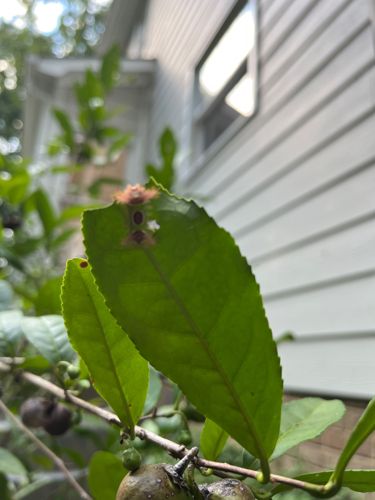Moth larva (general)
Scientific Name: Too broad to specify without clearer identification. Could be numerous species within Lepidoptera.
Order & Family: Lepidoptera (Moths and Butterflies), Family would vary greatly depending on species (e.g., Tortricidae, Lyonetiidae, Gracillariidae for leafminers/rollers)
Size: Larvae can range from a few millimeters to several centimeters, depending on the species and instar. The damage suggests a relatively small to medium-sized larva, likely under 2 cm.

Natural Habitat
Found on various host plants, typically in gardens, agricultural fields, forests, and natural landscapes. The specific plant species hosting the larva would provide more precise habitat information. The image shows it on a broadleaf plant, possibly citrus given the fruit-like structures below, which are common hosts for many moth species.
Diet & Feeding
Herbivorous. Depending on the specific species, moth larvae can feed on a wide variety of plant parts, including leaves, stems, fruits, and roots. In this case, they are feeding on the leaf tissue of the plant.
Behavior Patterns
The visible signs on the leaf suggest the presence of moth larvae, likely in a leaf mining or leaf rolling stage. Many moth larvae create shelters by rolling leaves or mining between leaf surfaces. The webbing and chewed areas are characteristic of their feeding and protective behaviors. The brown, fuzzy elements might be remnants of larval cocoons, frass, or part of a rolled leaf structure.
Risks & Benefits
Potential Risks: Moth larvae can be significant agricultural and horticultural pests, causing damage to crops, ornamental plants, and trees. Heavy infestations can defoliate plants, reduce yields, or even lead to plant death. Potential Benefits: In their adult stage, some moths are pollinators. Larvae also serve as a food source for various predators, contributing to the food web.
Identified on: 8/27/2025